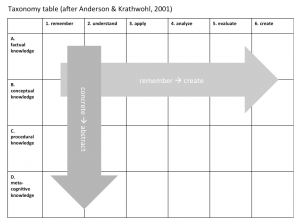
Currently reading: A revision of Bloom’s taxonomy of educational objectives
I am currently reading the Anderson & Krathwohl (2001) revised taxonomy of learning outcomes. They modified some of the higher levels of the original Bloom (1956) taxonomy and now use a continuum of cognitive processes from “remember” to “create”. They also introduced a second dimension of types of knowledge, ranging from concrete to abstract. While they break those two dimensions down into discrete categories for discussion, they point out that the categories lie along a continuum, similar to how colors lie on a continuum of wave lengths of light.
I have recently worked a bit on how using taxonomies of learning outcomes can help me give advice to university teachers, and reading the book was really helpful, because they break down the categories and give examples how learning objectives in each of the categories can be assessed.
For example the most basic category, “remember”, can consist of either recognizing or recalling, which would be assessed in different ways. Whether students recognize something can be tested by asking verification questions: “Is it true or false that …?”. Students could also be asked to match corresponding items on two lists or to find a best choice in a multiple choice scenario. Recalling, however, might be assessed by giving a prompt and asking students to complete: “A freak wave is a wave with a wave height that ___”.
If you are interested in learning more about how learning outcomes can help you in planning your teaching, check out this awesome resource and stay tuned – I will be back with more!
—
Bloom, B., Englehart, M. Furst, E., Hill, W., & Krathwohl, D. (1956). Taxonomy of educational objectives: The classification of educational goals. Handbook I: Cognitive domain. New York, Toronto: Longmans, Green.
Anderson, L. & Krathwohl, D. (Eds) (2001). A taxonomy for learning, teaching and assessing. A revision of Bloom’s taxonomy of educational objectives. Pearson Education

alexmurray1993 says:
Thank! I used your image in a report for my Masters of teaching. Good read